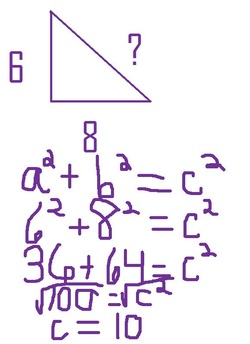Here are the three types of linear equations we have studied so far during Unit 6:
y=mx+b is the slope intercept form.
An example would be: y=3x+4
Ax+By=C is the standard form.
An example would be: 4x+7y=19
(y-y1)= m(x-x1) is the point slope form.
An example would be: y-3=-2/3(x-9)
Section 3-9
The Pythagorean Theorem
In this section, we learned all about the Pythagorean theorem of triangles.
What is the hypotenuse of a triangle? What are the legs of a triangle? What in the world is the Pythagorean theorem????
Look at the blue lines of the triangle. The lines both intersect each other at a 90 degree or right angle. These lines are the legs of the triangle. The leg of a triangle is one of the sides that make up the right angle in a right triangle.
The orange line is not the leg of the triangle. Instead, it is the hypotenuse. The hypotenuse of a right triangle is the side opposite of the right angle. It is also the longest side of the triangle.
Once you know the sides of the triangle, you can plug in the numbers to the Pythagorean theorem. The Pythagorean theorem is the relationship of the lengths the sides of a right triangle. The formula is in blue and orange to help you know where the sides go in the equation. Let’s try an example:
Vocabulary Words
Probability- how likely it is that something will occur
Outcome- the result of a single trial
Sample space- all possible outcomes of an event
Event- any group of outcomes in a set with probability
Theoretical probability- the ratio of the number of outcomes
Experimental probability- probability based on data collected from
repeated trials
Odds- describes the likelihood of an event by comparing favorable and
unfavorable outcomes


 RSS Feed
RSS Feed